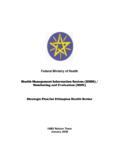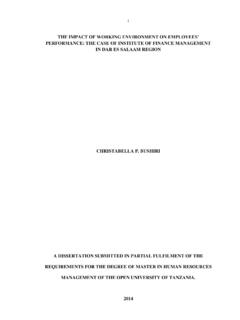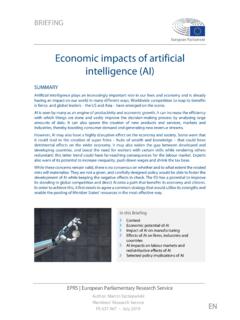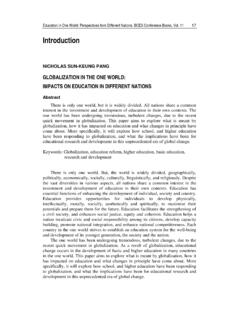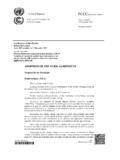Transcription of Ethiopia 2030: The Pathway to Prosperity
1 Ethiopia 2030: The Pathway to Prosperity Ten Years Perspective Development Plan (2021 2030). Content 1. Baselines and Assumptions 2. Strategic pillars 3. Departures 4. Macroeconomic goals 5. Implications of the COVID-19 pandemic and necessary mitigation measures 6. Potentials/capabilities 7. Focus areas Productive sectors Services sector Enabling sectors 8. Balanced and competitive development (nationally, regionally and locally). 9. Monitoring and Evaluation 1. Baselines and Assumptions Key performances of previous years Poverty Reduction (%). GDP growth rate (%). Proportion of people living below poverty line GTP II: 2019/20 (projection, with 50. COVID-19) 45. 40. GTP II: 2018/19 9. 35. GTP II: 2017/18 30. Percent 25 19. GTP II: 2016/17 20. 15. GTP II: 2015/16 10. 5. GTP I: 2011-2015 0.
2 1994 2000 2005 2011 2016 2020. 0 2 4 6 8 10 12 Year 1. Baselines and Assumptions Share of economic sectors in GDP (%) Merchandise export as % of GDP. 50 10. 45. 45 9 8 Percent 40 7 35 6. 30 5 Percent 25. 21 4 20 3. 15 15 12. 2. 1. 10 0. 5. 5 0. 2010/11 2011/12 2012/13 2013/14 2014/15 2015/16 2016/17 2017/18 2018/19 Year Agriculture Industry Manufacturing Construction Services 1. Baselines and Assumptions labour force participation (2013) Urban labour force participation (2013). 7%. 22%. 20%. Agriculture 7% 71% Industry Agriculture 73% Services Industry Services 1. Baselines and Assumptions High and increasing unemployment Rate 471,535 Urban unemployment rate = in 2018. 402,869. Youth unemployment rate = %. Male = Female %. Rural unemployment rate = 2% in 2013. Male Female Total Male Female Total Declining per capita rural land creating 2014 2018.
3 15-19 yr. 20-24 yr. 25-29 yr. Linear (20-24 yr.) disguised unemployment Number of unemployed people in urban areas 1. Baselines and Assumptions Challenges 1. Macroeconomic imbalances 2. Vulnerability to shocks (COVID-19, Climate Sustained high inflation changes, Desert Locust infestation, etc). High and rising unemployment especially 3. Poor quality and high inequity in in urban areas infrastructure projects High and rising debt burden 4. Poor quality services in health and Chronic foreign currency shortage education Sluggish (though encouraging) rate of High repetition and dropout rates from school structural change 1. Baselines and Assumptions Major areas of failure in the economy Provision of quality services Poor quality of growth and slow Low reward for merit, productivity and effort (electricity, water, telephone, structural change while low disincentive for laziness, wastefulness internet) and corruption Excessive aid and loan Creation of enough jobs and Slow institutional change and transformation in.
4 Dependence for financing improved living standards infrastructural and construction Government policies Generation of reliable foreign investments Investor attitude exchange revenue and debt- Limited success in expanding Youth behaviour sustainable national economic manufacturing and modern Role of the intellectuals capacity agriculture which have high job The need for sustained increase in production creation potentials and productivity Completion of development projects and investment plans Weak institutional capacity as The need to set a common national vision to achieve major successes with consensus and under public-private the main culprit of all failures popular legitimacy partnerships 1. Baselines and Assumptions Vision 2030; Ethiopia : An African Beacon of Prosperity Prosperity ensures material needs, dignity, equality and freedom Indicators of Prosperity 1.
5 Physical, human and institutional capital for income generation and Human Development asset accumulation Index (HDI). 2. Equitable access to education, health and other services for improved utilization of potentials and assets creation Multidimensional Poverty Index (MPI). 3. Unconditional access to the basic necessities of life food, shelter, clean water, basic health and education Living standards and 4. Economic, social and political participation without discrimination wellbeing perception index ethnic, religious, demographic, and gender 5. Overall affirmative system built on consensus 2. Departures 1. Emphasis on quality of economic growth 2. Participation and coordination of sectors in the planning process 3. Sectoral linkages and multi-sectoral development focus 4.
6 Preparation of national development corridors based on development potentials 5. Focus on solving institutional bottlenecks 6. The ongoing home grown economic reform programme as a sprinting board 7. Emphasis on resilience building, innovation and entrepreneurship 3. Strategic pillars 1. Ensure quality growth 2. Improve productivity and competitiveness 3. Undertake institutional transformation 4. Ensure private sector's leadership in the economy 5. Ensure equitable participation of women and children 6. Build climate resilient green economy 3. Strategic pillars quality economic growth 2. Raising production and productivity Increasing export revenues and substituting imports by The economic growth should ensure: reducing production costs Participation of all citizens and equitable utilization of the growth proceeds Availing quality and massive infrastructure Improved standard of living of every citizen Linking infrastructural development with development corridors Reduced poverty in all indicators Producing required human resources with quality Reduced inflation and unemployment Producing enough and quality human resources The economic growth should lead to increased Prioritizing innovative production systems aggregate supply Linking incentives with export revenue and job creation Focus on modern agriculture.
7 Manufacturing and performances mining Modernizing and enhancing the logistic system Emphasis on exploiting the sources of growth through structural change Creating technological competences needed for long- term growth 3. Strategic pillars 3. Institutional Transformation 4. Private sector's leadership in the economy Build democratic and judicial institutions that ensure elite bargain, Create conducive investment climate and incentivize national consensus, common vision and government legitimacy domestic investors in key sectors Build private sector and competition friendly bureaucracy Build strong and market-led public-private partnerships in Coordinate with parents, the society and teachers to make order to ensure the establishment of inclusive and educational institutions centers of excellence and virtuous citizens pragmatic market economy Coordinate with parents as well as social and religious leaders to Enhance access and quality of infrastructure to attract encourage religious institutions and their teachings contribute quality foreign direct investment Identify new sources of growth, empower and stimulate towards poverty reduction efforts the private sector, and supplement the private sector in Prepare policies.
8 Strategies and legal frameworks for achieving strategic areas Prosperity Emphasis for public-private partnership on problem Increased focus on innovation and research solving innovations and research activities Creating strong social security system 3. Strategic pillars 5. Equitable participation of women and children 6. Climate resilient green economy Ensure gender equity in economic and social Increase basin development efforts to fight land sectors degradation and to reduce pollutions Participation of women at all levels of education Improve productivity and reduce GHG emissions Asset ownership of women Increase forest protection and development Ensure fair participation of women and youth in Increase production of electricity from renewable leadership and decision making positions sources for domestic use and for export Create awareness among citizens about the role of Focus on modern and energy saving technologies women and youth in the country's overall development 4.
9 Macroeconomic Goals Assured middle- income potential Sectoral growth Targets (2021-2030). Average Growth Target Assumptions Make Ethiopia a middle income economy by 2022. Requirement to significantly reduce poverty Raise per capita income to USD 1,115. Percentage of population below poverty line in 2022. Available national potentials Threshold for middle-income is USD 1,026. Potential for investment in the economy Plus human development index and economic vulnerability index Existing potentials in each sector Raise per capita income to USD 2,220. Low productivity that needs to be by 2030. improved 4. Macroeconomic Goals Structural change Sectoral composition of GDP labour force participation Financing Gaps Economic Performance Target Sectors 2011 2015 2018/19 2030. Agriculture 45 Industry Manufacturing Services 39 Reduce urban unemployment to less than 9%.
10 Million new jobs need to be created per annum 5. Implications of the COVID-19 pandemic and necessary mitigation measures GDP growth for 2019/20 fiscal year is projected to be lower than its target of by between and percentage points (equivalent to - billion birr) due to COVID-19 pandemic If the current scenario continues, next year's GDP growth could decline by percentage points Returning the economy to its high growth trajectory requires focusing on sectors with high productivity and job creation potentials Public investment should focus on empowering the private sector Promoting both domestic and foreign investments with the right set of incentives (merit based). Modernizing production systems and improving uptake of technology Conducting demand analysis for export commodities to remedy for the declining trend in exports and foreign exchange earnings.


